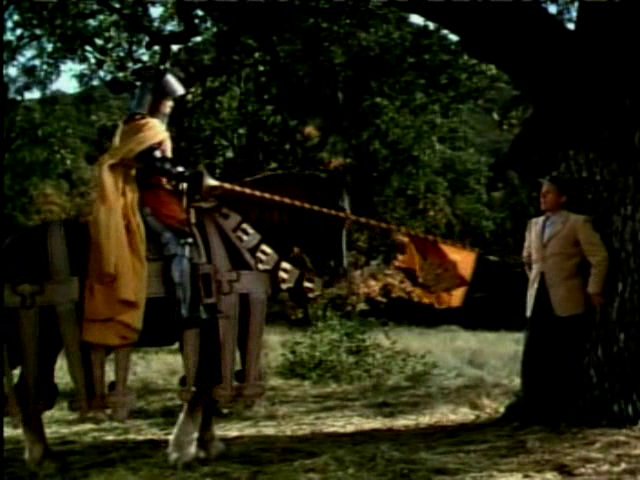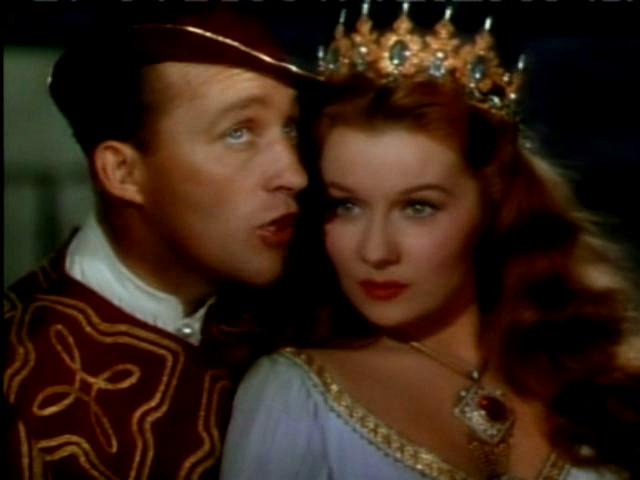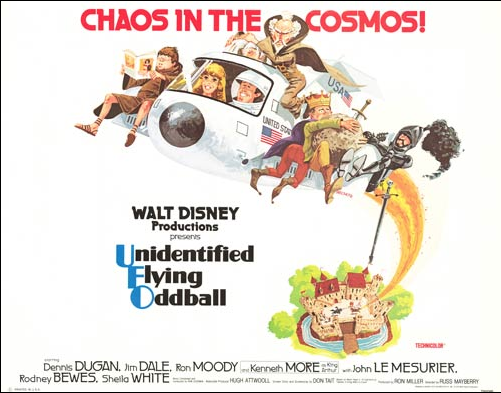The movie follows the basic structure of Mark Twain’s book with Hank Martin (Bing Crosby), an American blacksmith turned auto-mechanic, who is knocked out and wakes up in the time of King Arthur. After awakening under an oak tree, Hank is surprisingly accosted by a mounted knight, Sir Sagramore (William Bendix), who accuses Hank of being a monster and then drags him to the Court of Camelot. Now, I’m not saying Bing Crosby’s attire in this movie is all that stylish but it’s certainly not monstrous, which makes this whole sequence rather ridiculous. In the book, he’s just challenged to a joust for the simple crime of being a weirdly dressed stranger but in the movie it makes Sir Sagramore come across as a buffoon.
The Road to Camelot sure is dangerous.
Hank is brought before King Arthur (Cedric Hardwicke) and is quickly accused of being a shape-shifting ogre and sentenced to burn at the stake, but with the judicious use of a piece of glass and the sun Hank is able to create fire and impress the local nobility. This does not sit well with Merlin (Murvyn Vye), Arthur’s scheming court magician, and between him and Morgan le Fay (Virginia Field) the two put into motion a plot to get rid of Hank. This scheme hinges on the discovery of the budding romance between Hank and King Arthur’s niece Alisande la Carteloise (Rhonda Fleming), who is betrothed to Lancelot (Henry Wilcoxon), a jealous knight who challenges Hank to a duel to the death. Due to Hank’s calf-roping skills - which all auto-mechanics apparently have - this plan fails and the jousting Lancelot soon finds himself hogtied and defeated, but the humiliation of such a noble knight causes Alisande to turn her back on Hank.Hank is the winner of the Camelot Stampede.
Paramount’s musical take on Mark Twain’s novel is only slightly above being an “In name only” adaptation, we do get Hank taking a disguised King Arthur out into his kingdom so as to show the monarch the true wretched condition of his subjects, but the film completely misses the satiric elements of Twain’s story. At most this movie makes fun of monarchy, with Arthur being an inept rule who is manipulated by the likes of Merlin, but the book also questioned the ideals of capitalism and the outcome of the Industrial Revolution and the power of the church. Gone is Hank industrializing the country behind the backs of the rest of the ruling class, gone are the secret schools which taught modern ideas and modern English to the peasantry and thereby removing the new generation from medieval concepts, and gone is Hank’s continued debunking of all the alleged sorcerers and miracle-working church officials. Talk about a film missing the point of the source material.Note: This is one of the rare Arthurian stories where Merlin is the villain.
Stray Thoughts:• In the novel, the knight who first encountered Hank was Sir Kay but for some reason it was changed to the lesser-known Knight of the Round Table, Sir Sagramore. A knight who in the book is eventually shot to death by Hank.
• In the book, it was an upcoming solar eclipse that Hank used to impress the court but in this movie that is saved for the last act when he, Arthur and Sagramore are to be executed as escaping slaves.
• This is another King Arthur movie that includes Merlin and Morgan le Fay but does not have actual magic as an element. Even weirder is seeing Merlin and Morgan le Fay as partners in crime.
• The songs in this version are, as a whole, fairly forgettable and this is probably due to the fact that the studio was not allowed to use the songs from the original stage musical.
• Like most movies depicting medieval life the filmmaker chose weaponry and devices that did not exist in the 6th century – battlemented castles, full plate armour and a spyglass – but the film leaves out most of the devices that time travelling Hank did create, such as modern tools, weapons and even the telephone.
• I will freely admit that Bing Crosby had an excellent singing voice but as a romantic lead, he always left me rather cold.
It’s like watching your creepy uncle hit on your older sister.
I guess one could not expect to see the breadth and scope of Twain’s satiric story to make its way into a what was basically a light musical comedy – and I use the word “comedy” in the broadest sense of the word as there isn’t much one could quantify as funny in this film – but with the tepidly performed songs and the cheap sets and costuming there isn’t much in this adaptation of A Connecticut Yankee in King Arthur's Court to recommend, at most this film can be considered a novelty piece and shelved alongside the many other lesser Hollywood versions of Arthurian stories.Note: Funnily enough my favourite adaptation of Twain's story is the Disney film Unidentified Flying Oddball (1979).






No comments:
Post a Comment